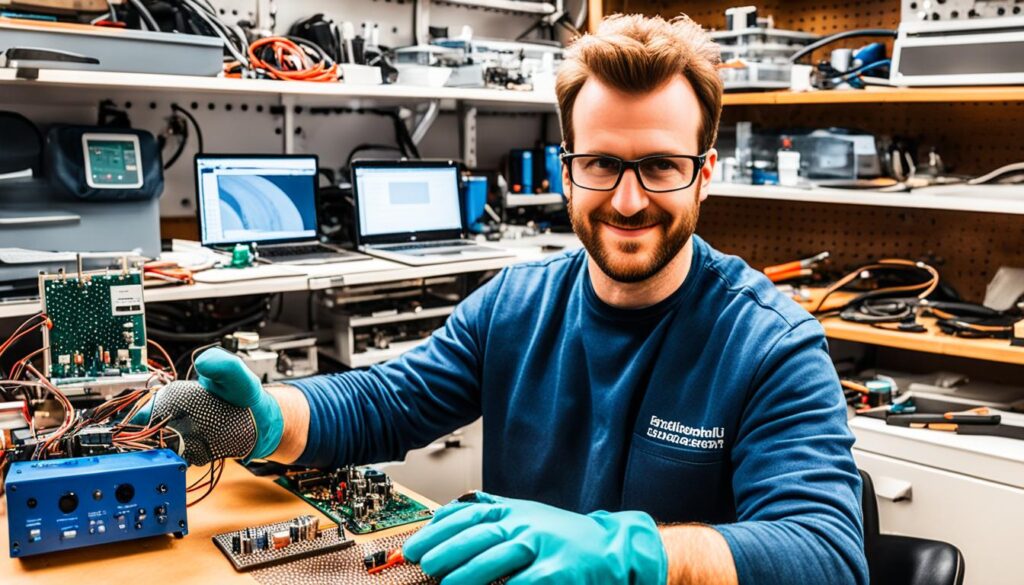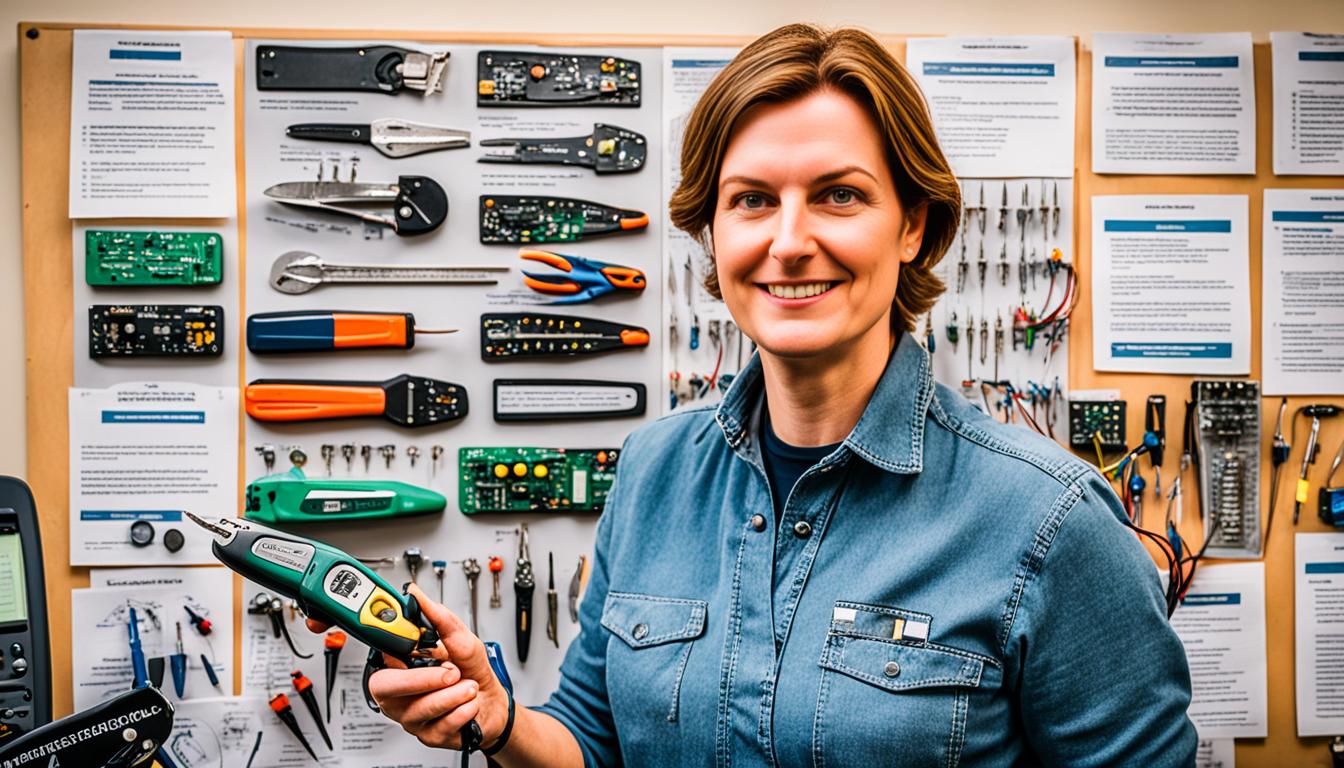Disclosure: This Post Contains Affiliate Links; We earn a commission on purchases.
Electric and magnetic fields (EMFs) are invisible areas of energy that are associated
with the use of electrical power and lighting. They can be categorized as non-ionizing or ionizing radiation, with non-ionizing radiation being perceived as generally harmless to humans. While there have been concerns about EMF exposure and its potential health effects, research has shown no conclusive evidence linking it to cancer or adverse health outcomes. However, in the age of technology, concerns about EMF exposure from devices such as cell phones and wireless routers persist. It is recommended to continue education on practical ways to reduce EMF exposures.
Key Takeaways:
- Empower yourself by learning about DIY EMF protection methods
- Explore EMF shielding projects to reduce exposure
- Create your own EMF protection using materials and techniques
- Stay informed and educate others about EMF risks and mitigation
- Take control of your EMF exposures and prioritize your well-being
Understanding the Different Types of EMFs
EMFs can be classified into two categories based on their frequency: non-ionizing radiation and ionizing radiation.
Non-ionizing radiation includes low to mid-frequency radiation, such as extremely low frequency (ELF), radio frequency (RF), microwaves, and visual light. Examples of sources of non-ionizing radiation include microwave ovens, computers, wireless networks, cell phones, power lines, and MRIs.
Ionizing radiation, on the other hand, refers to mid to high-frequency radiation that has the potential for cellular and DNA damage. Examples of ionizing radiation include ultraviolet (UV), X-rays, and gamma rays.
| Type of EMF | Frequency | Examples |
|---|---|---|
| Non-ionizing radiation | Low to Mid-frequency |
|
| Ionizing radiation | Mid to High-frequency |
|
Potential Health Risks of EMF Exposure
While there have been concerns about the potential health risks of electromagnetic field (EMF) exposure, the research findings regarding its link to cancer and other adverse health outcomes remain inconclusive. Some studies have shown a weak association between EMF field strength and an increased risk of childhood leukemia.
However, when it comes to adult cancers, such as brain cancer and breast cancer, the overall research on EMF exposure has not found conclusive evidence of a direct link. Despite this, the ongoing widespread use of devices emitting EMFs, such as cell phones and wireless routers, has raised concerns among individuals.
It is crucial to continue studying the effects of EMF exposure and to educate individuals about practical ways to reduce their EMF exposures. While the evidence may not definitively support a direct causal relationship between EMF exposure and cancer, it is essential to stay informed and take proactive measures to minimize potential risks.
Empowering Yourself with Knowledge
Understanding the potential health risks associated with EMF exposure empowers individuals to make informed decisions to protect themselves and their loved ones. While more research is needed to establish a conclusive link between EMF exposure and cancer, awareness and education are crucial in minimizing potential risks.
“Without conclusive evidence linking EMFs to cancer, it is important to stay vigilant and adopt precautionary measures to reduce EMF exposures in everyday life.”
Practical Ways to Reduce EMF Exposures
To minimize EMF exposures, consider the following steps:
- Avoid prolonged and close proximity to devices that emit high levels of EMFs, such as cell phones and wireless routers.
- Use speakerphone, earphones with air tube technology, or wired headsets to reduce direct exposure during phone calls.
- Keep electronic devices away from the body when not in use, especially during sleep.
- Limit the use of wireless devices and opt for wired alternatives whenever possible.
- Create EMF-free zones in your home by turning off Wi-Fi routers at night and keeping electronic devices at a distance.
- Consider using EMF shielding products, such as EMF-blocking fabrics or phone cases, to reduce direct exposure.
By implementing these practical measures, individuals can actively reduce their EMF exposures and take control of their well-being.
DIY EMF Shielding Projects
For individuals who want to take control of their EMF exposures, there are various DIY EMF shielding projects that can be undertaken. These projects enable you to create your own EMF-blocking solutions at home using materials that absorb or reflect electromagnetic fields. By engaging in these DIY projects, you can reduce your exposure to EMFs and create your own homemade EMF protection.
Here are some examples of DIY EMF shielding projects:
- Using EMF-blocking fabrics: Sewing curtains, bed canopies, or clothing using special fabrics that are designed to block EMFs can provide effective shielding.
- Building Faraday cages: Constructing a Faraday cage using conductive materials can create a protective enclosure that blocks electromagnetic waves.
- Utilizing EMF-shielding paints or wallpapers: Applying EMF-shielding paints or wallpapers to your walls can create a barrier that helps reduce EMF exposure in your living spaces.
- Creating EMF-blocking devices: Crafting EMF-shielding cases for your electronics, such as cell phones or tablets, using conductive materials can help minimize EMF emissions when using these devices.
By undertaking these DIY EMF shielding projects, you have the opportunity to personalize and customize your own EMF protection solutions. Whether it’s incorporating EMF-blocking fabrics into your home decor or building a Faraday cage to shield your bedroom from EMFs, the choice is yours. Take the initiative to create your own EMF protection and empower yourself with a safer, low-EMF environment.
Expert Insight:
“DIY EMF shielding projects not only offer a practical way to reduce EMF exposures but also allow individuals to gain a deeper understanding of the electromagnetic field and its potential impacts. By creating their own EMF protection, individuals can take control of their environment and make informed decisions about their exposure to EMFs.”
– Dr. Emily Roberts, EMF Researcher
With these DIY EMF shielding projects, you can actively participate in safeguarding yourself and your loved ones from excessive EMF exposure. By creating your own homemade EMF protection, you are taking a proactive step towards maintaining a healthier and more balanced living environment.

Wearable EMF Protection Devices
To enhance personal EMF protection, there are wearable devices available that can block EMFs. These devices, such as EMF-blocking headbands or EMF-blocking hats, utilize innovative techniques to disrupt brainwave signals and make it challenging for mind-reading technology to accurately interpret a person’s thoughts. These wearable gadgets can serve as stylish defense mechanisms against invasive mind-reading attempts and provide an additional layer of protection for the individual.
Benefits of Wearable EMF Protection
Convenient and portable: Wearable EMF protection devices are designed to be lightweight and easy to carry, allowing individuals to have constant protection wherever they go.
Stylish and fashionable: EMF-blocking headbands and hats are available in a variety of designs and colors, allowing individuals to express their personal style while staying protected.
Discreet and versatile: These devices can be worn discreetly, blending seamlessly into everyday outfits, making them suitable for various occasions.
“Wearable EMF protection devices offer a practical and fashionable way to safeguard yourself from the potential risks of EMF exposure.” – Expert

Choosing the Right Wearable EMF Protection Device
When selecting a wearable EMF protection device, consider the following factors:
Protection level: Look for devices that provide a high level of EMF-blocking capability to ensure maximum protection.
Comfort: Opt for devices made from breathable and lightweight materials for all-day comfort.
Compatibility: Consider the compatibility of the device with your lifestyle and attire, ensuring it integrates seamlessly into your daily routine.
By incorporating wearable EMF protection into your daily life, you can proactively mitigate the potential risks associated with EMF exposure and maintain a greater sense of well-being.
Mindfulness and Meditation as EMF Protection
Cultivating mindfulness and engaging in meditation practices can serve as powerful tools for EMF protection. By practicing mindfulness, individuals can sharpen their awareness and detect any potential intrusive thoughts or attempts to access their mind. This heightened sense of attention enables them to identify and address any potential sources of electromagnetic radiation that may be affecting their well-being.
In addition to mindfulness, incorporating regular meditation sessions into one’s routine can provide further EMF protection. Meditation techniques, such as breath awareness or loving-kindness meditation, help individuals develop concentration, clarity, and mental resilience. Through these practices, one can strengthen their cognitive defenses against external influences, including electromagnetic fields, and establish a sense of inner peace and stability.
Practicing mindfulness and meditation can help individuals regain control over their thoughts and strengthen their mental resilience, offering an additional layer of protection against the potential effects of EMF exposure.
By integrating these mindfulness and meditation practices into their daily lives, individuals can enhance their well-being and minimize the potential impact of EMFs. Not only do these practices contribute to overall mental and emotional balance, but they also support individuals in taking proactive steps toward self-care and EMF protection.
Physical Measures to Block EMFs
In addition to DIY projects and wearable devices, there are physical measures that can be taken to block electromagnetic fields (EMFs). By incorporating physical barriers and utilizing shielding materials, you can create an extra layer of protection against EMF exposure. Additionally, there are specialized EMF protection devices that can neutralize or redirect EMF emissions.
Shielding Materials for EMF Protection
Shielding materials, such as specialized fabrics, foils, or meshes, can be used to create a physical barrier against EMFs. These materials work by absorbing or reflecting electromagnetic fields, reducing their impact on your surroundings. You can use them to shield specific areas in your home, such as bedrooms or workspaces, where you spend a significant amount of time.
“By incorporating shielding materials, you create a physical barrier that helps block EMFs, reducing your overall exposure.”
To effectively block EMFs, choose shielding materials that have a high conductivity and surface coverage. Copper or aluminum-based fabrics, for example, are commonly used for their electromagnetic shielding properties. These fabrics can be used to line walls or create curtains, providing a shielded environment for enhanced EMF protection.
EMF Protection Devices
In addition to shielding materials, there are various EMF protection devices available in the market. These devices are designed to neutralize or redirect EMF emissions, providing an added layer of protection against harmful electromagnetic radiation. EMF protection devices come in different forms, such as pendants, bracelets, or stickers, and can be easily incorporated into your daily life.
EMF protection devices work by utilizing advanced technologies that interact with electromagnetic fields. They may neutralize EMFs or transform them into harmless frequencies, reducing their potential health risks. Wearing an EMF protection pendant, for example, can help minimize the effects of EMF exposure from everyday devices like cell phones, laptops, or Wi-Fi routers.
Take Charge of EMF Protection
By incorporating physical measures such as shielding materials and EMF protection devices, you can take charge of your EMF protection. These measures create a physical barrier against EMFs and help reduce your overall exposure to electromagnetic radiation. Whether you choose to line your walls with shielding fabrics or wear an EMF protection pendant, these physical measures provide an additional layer of defense in the modern digital age.
Conclusion
In conclusion, DIY EMF protection empowers individuals to take control of their EMF exposures and reduce the potential risks associated with EMF exposure. By understanding the different types of EMFs, such as non-ionizing and ionizing radiation, individuals can make informed decisions about their EMF shielding needs.
Implementing various protective measures, such as DIY projects, wearable devices, mindfulness practices, and physical barriers, can significantly contribute to creating a safer environment and minimizing EMF exposures in everyday life.
It is essential to continue educating oneself about EMF protection and stay vigilant in reducing EMF exposures. By staying informed and implementing practical solutions, individuals can maintain their privacy and well-being in an increasingly connected world. Final thoughts on EMF shielding emphasize the importance of taking proactive steps to protect oneself and promote a healthier lifestyle.
Source Links
- https://www.niehs.nih.gov/health/topics/agents/emf
- https://www.opal.so/blog/how-to-block-mind-reading-technology
- https://www.weather.gov/oun/stormanxiety

Subscribe to Our Newsletter










